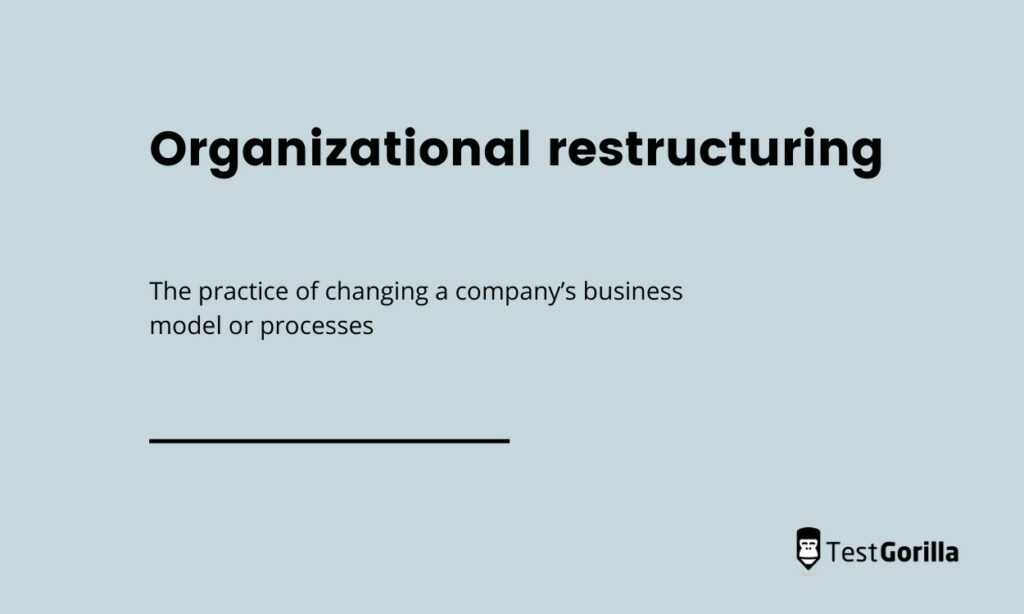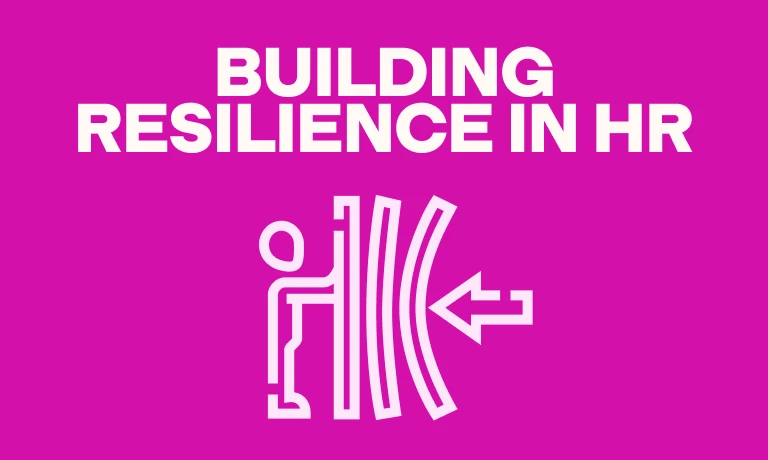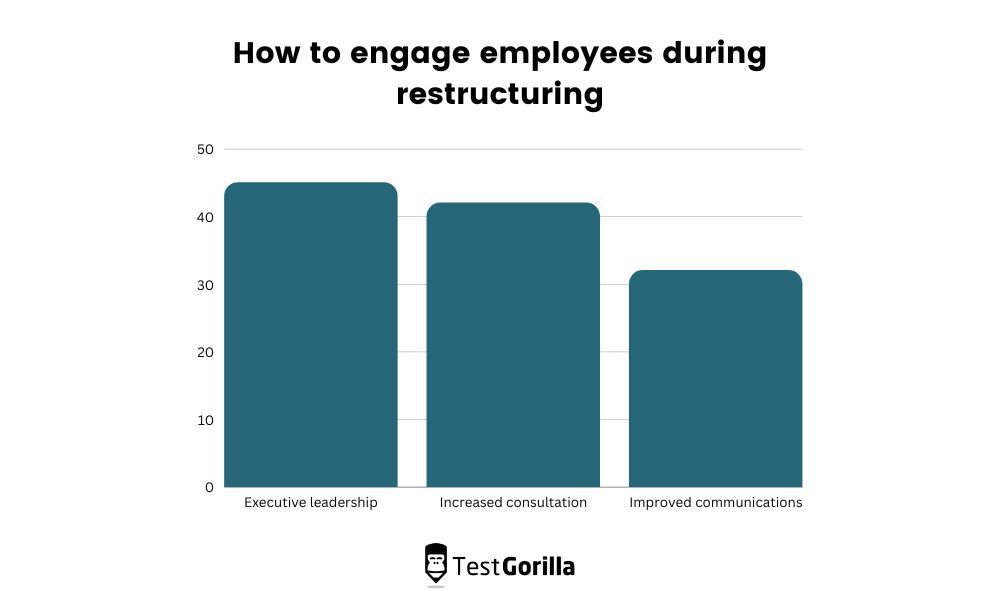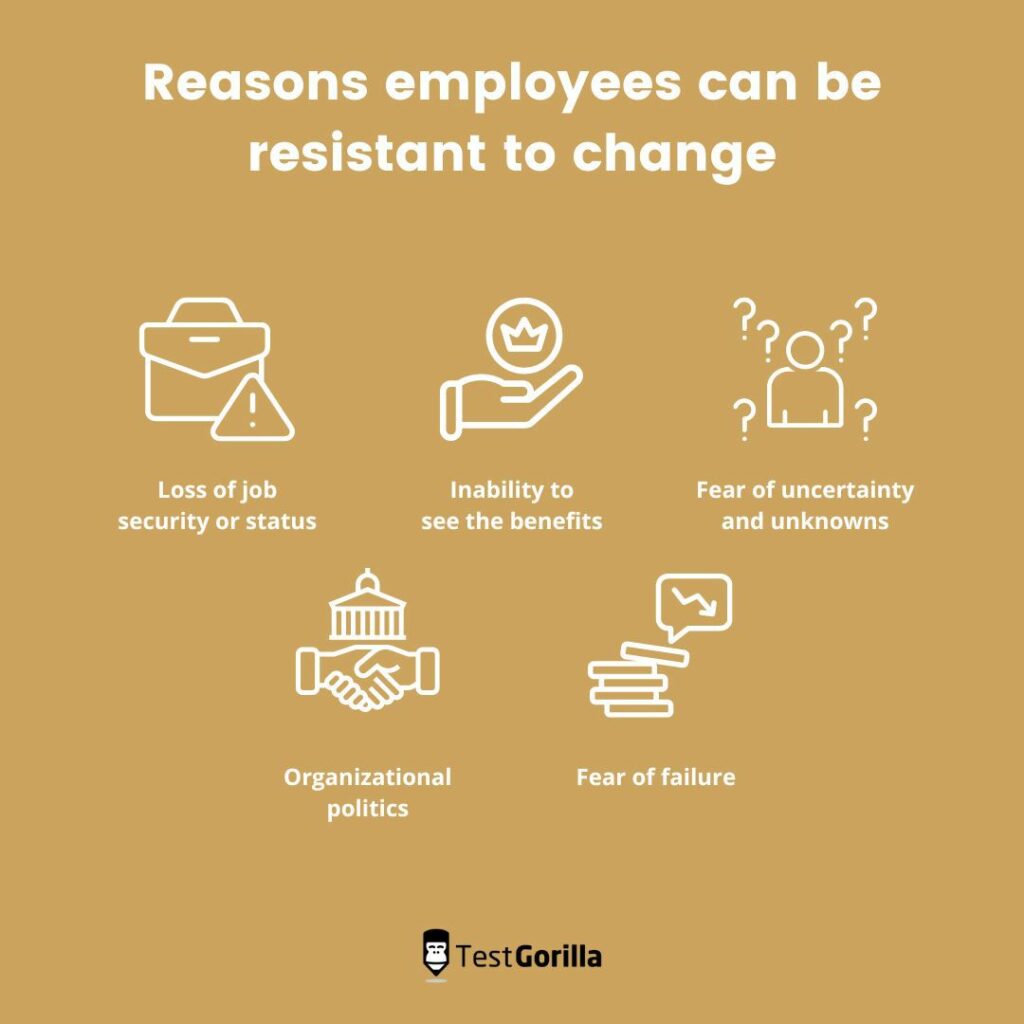HR professionals play a pivotal role in any type of organizational restructuring.
Communicating changes, reskilling, rehiring, and employee support all fall upon the shoulders of the hardworking HR professional.
The HR department manages people, and people can make or break the change. And given that only 34% of change initiatives are a clear success[1], your organization needs its HR professionals to be at their best.
This guide takes an in-depth look at organizational restructuring from an HR perspective, including HR’s role throughout the four main restructuring steps. It also offers six best practices to simplify and streamline your company’s restructuring initiative.
Table of contents
What is organizational restructuring?
Organizational restructuring is the practice of changing a company’s business model or processes. This can include changing roles and responsibilities, company practices, or the organizational hierarchy.
Restructuring can be a small change that takes a matter of months or something much larger that takes years to complete fully.
For example, Honda began its electrification restructuring this year, aiming to shift its focus to recurring services instead of product sales, increase its software budget, and launch 30 new electric car models globally by 2030.
This restructuring will change many core elements of Honda’s processes, and it’s estimated that it will take more than 10 years.
Why do companies restructure their business operations?
The world moves fast, and a 2020 study showed that 60% of organizations need to restructure at least every three years to stay afloat, with 16% needing to reinvent every 12 months.
However, “staying afloat” is a vague phrase.
What’s the real reason behind restructuring?
Here are the top reasons for restructuring a company:
Reason | Description |
1. Changes in leadership or ownership | The new leader wants to rebrand or reshape the company, which will require legal and organizational changes |
2. Pressure from competitors | If your competition adopts new processes and practices, your company must respond to stay relevant |
3. Changes in customer needs | Companies may need to restructure to offer new products or services to customers |
4. External economic and political factors | World events, such as the current inflation crisis, the pandemic, or the war in Ukraine, can impact a business or call for a change in its processes |
5. Poor/declining financial results, insolvency, or bankruptcy | A change in processes or business objectives and/or financial restructuring may be necessary to remain in business when profits are low |
5. A cost-reduction strategy | A business might restructure itself to increase budget efficiency, such as by decreasing overhead spending or reallocating the use of the budget |
6. New market opportunities | An organization may take advantage of new market opportunities, such as launching products in new markets or increasing brand awareness |
7. Mergers and acquisitions that lead to rebranding | New leaders or managers may want to rebrand or change business processes |
8. Divestments and spin-offs | Selling certain assets or establishing a spin-off company may require a lot of restructuring |
No matter the reason, companies need to respond to changes to stay efficient, productive, and profitable.
The best insights on HR and recruitment, delivered to your inbox.
Biweekly updates. No spam. Unsubscribe any time.
Who’s involved in organizational restructuring?
Everyone in the company is at least somewhat involved in organizational restructuring, from the chief executive officer to the newest intern.
But reorganization affects everyone differently.
Let’s take a look at the major actors in a company restructuring and the role each of them plays:
Management: People in management roles focus on keeping the business running smoothly, despite the many changes and challenges. They may also help create a restructuring plan, evaluate restructuring activities, and provide support where needed.
Employees: Restructuring doesn’t always directly involve employees, but including them and keeping them informed increases the chances of success and reduces opposition.
Investors: Companies with heavily involved investors usually include them in major decisions, which could significantly affect the process.
HR staff: HR professionals map out and guide the restructuring process, communicate the changes to employees, and help them get through the difficulties.
A successful restructuring hinges on the HR staff as the foundation, so let’s go over how to lay down that foundation.
HR’s role in restructuring a company
HR is involved from the beginning of a restructuring to the end. They also communicate with many different levels of the company.
Let’s go through the steps to restructure a department or company and how HR guides that journey.
Here’s a quick summary of each stage and an HR professional’s responsibilities during them:
Stage | Description |
1. Planning stage | Assess your status quo, learn your workforce’s current skills, and map out your new structure |
2. Communication stage | Discuss the change with employees, offering transparency and support wherever possible |
3. Implementation stage | Roll out the changes, help workers ease into new roles, and handle layoffs delicately |
4. After restructuring is complete | Monitor progress, review changes, and support employees as they adjust to their new positions |
Now, let’s discuss each of these stages in depth.
During the planning stage
Properly planning your organizational restructuring is essential. It gives you vital information about what skills you need, what skills you already have, and how best to execute the restructuring.
Planning can make the difference between failure and success, and HR lends an important hand in it.
The first step in the planning stage should be to examine the current status quo. Make sure you’re clear on:
Your current organizational structure
The company’s overall future direction and goals
Your current workforce’s skill sets and any skill gaps
To better understand and define the skills of your workforce and any gaps it possesses, perform a skills gap analysis with online skills testing to assess your employees.
For example, you could evaluate your current programming staff with tests like the following:
The results give you key insights into which positions you should place these workers and any new hires you have to make.
After you have a firm grasp of your employees’ skills, it’s time to develop a new organizational structure. This structure should:
Be based on the restructuring’s overall goals
Tie into cost requirements
Relate directly to performance goals
Account for legal and economic constraints
Consider staff strength
After you’ve made and documented these considerations, you can start redesigning job roles and responsibilities, keeping in mind the necessary skills.
Throughout the process, you can compare new job roles with old ones to better understand their differences and similarities. This helps you determine which employees are best for the role and whether they’ll require additional training.
While creating the new structure, ensure that you understand all legal implications of the change and get any legal help you need to follow through successfully.
More on that later. If you’d like to jump straight there, click here.
During the communication stage
Communication is a strong, healthy foundation for support during tough times. Gartner reports that 73% of change-affected employees experience highly elevated stress levels, which causes a 5% drop in their performance.
Take the lead in breaking the news to your business, and offer your staff plenty of support and guidance.
The goal is to minimize uncertainty and help everyone throughout the transition, whether they end up in a new role or a different company.
Communication should include not only the “why” but also the “what” of everything that’s going on:
Why? Give a solid reason behind the organizational change.
What? Describe exactly what’s happening and who’s going to be affected.
This helps clear the air of uncertainty, provides transparency, and reduces overall opposition.
Another important aspect of the communication stage is to express the benefits of the restructuring and how it will positively impact the company (which also helps to reduce opposition).
Put forward the new strategies and direction and how they’ll provide an advantage or solve an issue.
Then there’s the task of communicating with those who will be let go during restructuring.
These people require support, understanding, and a delicate hand. Assure them that it isn’t their fault, and take any steps you can to support them through this difficult outcome, such as offering outplacement services or even just someone to talk to.
During the implementation stage
It’s time to put the plan into action and begin redeploying employees into new roles.
Redeploy employees based on their skills and expected performance, gradually switching all workers over to the new structure.
As the implementation rolls out, offer training, coaching, and development opportunities for your affected staff. Some workers may need a new skill or two (perhaps their existing role merged with another?), but others may require more extensive reskilling.
For example, maybe you’re relocating an excellent sales representative to a marketing role. The roles have some skills in common, but you can better prepare the rep by finding any skills gaps with online skills testing.
Here’s an example assessment for our new marketer:
Role | Tests |
Digital marketing executive |
You can also use skills testing to help you hire new employees as you start to focus recruitment efforts on filling gaps in the new structure.
After your earlier skills gap analysis, you’ll know what to look for and can create assessments that perfectly suit your candidate persona.
You handle redundancies and layoffs at this stage. It’s best to be careful, discreet, and respectful. Layoffs are often necessary for restructuring, but they are a delicate business.
For in-depth information and best practices, read our guide on how to lay off employees.
Implementation is a difficult step for everyone, so it’s critical to maintain a positive work environment and celebrate success whenever you can.
You can celebrate new role success, increased customer satisfaction, cost savings, and higher efficiency with your people.
After the restructuring is completed
Even after the organizational restructuring is technically complete, you still need to help employees adjust.
Offering ongoing support to your employees is absolutely necessary – support is not a one-and-done deal and should be continuous.
An excellent way to facilitate employee support is through regular 1:1 meetings. Try to check in with each employee every one to two weeks to discuss struggles, successes, and future goals.
For any employee having difficulties meeting new role requirements, perform another skills gap analysis to discover where they’re having trouble, and provide the proper training to help them out.
The period after the restructuring is also a crucial time to shape the future culture of your organization.
Restructuring a company is a sort of rebirth, so this is your chance to weave positive practices and habits into your culture – like healthy communication and the idea of work being a “safe space” to talk about mental health.
Reshaping your culture also helps employees adjust to change. One study showed that 67% of organizations made a culture shift to ease a restructuring change.
Company culture is one of the most important elements of a business. There’s a reason it’s one of the top job satisfaction factors.
This is also the time to review the success of the restructuring and work with top management to correct any problem areas.
Here are a few tips for a successful review:
Ensure your review is honest, comprehensive, and transparent
Take time to accurately assess ROI
Consider business and behavioral metrics when examining data
Remember that an organizational restructure continues to be “new” long after it’s officially done on paper. Your role is to be strong and supportive and make adjustments to ensure continuous improvement.
6 HR best practices to implement during business restructuring
Now let’s cover our top strategies to make organizational restructuring easier on you and your employees.
Here’s a quick summary of them:
Tip | Description |
1. Overcommunicate everything | Keep current communication with higher-ups, stakeholders, and employees |
2. Anticipate and plan for employee resistance | Workers will have apprehensions and fears, so be prepared to address them |
3. Be sure to check local regulations when you have a remote workforce | Consider legal implications surrounding remote workers and if they’ll be affected |
4. Provide outplacement services to the employees you lay off | Lend a hand to displaced employees by offering them help in finding new work |
5. Offer stress management and mental well-being training and support | Support your workers with mental well-being programs and stress management |
6. Keep employees focused on their performance goals and productivity | Ensure productivity and work continues as usual during the restructuring |
Let’s discuss these points.
1. Overcommunicate everything
There’s no such thing as too much communication.
It’s important to communicate with higher-ups and stakeholders to get information and updates and then relay that information to your employees.
Even small details are appreciated and lead to better relationships with workers. It also keeps them engaged throughout the process.
According to a Google survey, engaged employees make for better restructuring, and the best ways to engage them are with executive leadership (45%), increased consultation (42%), and improved communications (32%).
Give them minor updates, and tell them why they’re there with you, what you expect from them, and the direction that the company is headed.
You can give minor updates through group chats or email sequences, but it’s better to hold seminars or meetings for major ones.
All of this builds a solid atmosphere of trust in a time of uncertainty.
2. Anticipate and plan for employee resistance
Not many employees look forward to a restructuring initiative. Organizational restructuring is a major change that can cause layoffs, pay cuts, and a lot of hard work.
There is a smorgasbord of understandable reasons employees can be resistant to change:
Loss of job security or status
Inability to see the benefits
Fear of uncertainty and unknowns
Organizational politics
Fear of failure
Many, if not all, of your employees will face at least one of these challenges, so it’s best to be prepared and anticipate them.
Offer support, communicate changes to the best of your ability, talk about the changes through 1:1 meetings, and have deep discussions on employees’ issues with the changes.
If possible, refer employees to mental health programs your company supports, such as digital therapy or employee resource groups.
3. Be sure to check local regulations when you have a remote workforce
If you’re reshaping your practices and processes, ensure all your local regulations are in order if you have a remote workforce.
Your organizational change may involve moving to a new location, which means different remote laws will govern you.
All remote employees are under the law of whatever area you’re located in, regardless of their location.
Research state and local employment laws and how they pertain to remote employees, seeking the guidance of a lawyer to ensure you dot every “I” and cross every “T.”
Even if you aren’t moving to a new area, when your business practices change, you have to be mindful of the legal side of things, especially if a remote worker’s role is being reshaped and reconfigured.
4. Provide outplacement services to the employees you lay off
Outplacement services help laid-off employees find new work. You can offer these services alongside severance pay in your separation agreement.
This might include career assessment, LinkedIn profile writing, networking help, and interview preparation.
Layoffs not only cut off employees’ source of income and security but also disrupt their roles, routines, and connections.
Executing the layoffs is one of the most difficult parts of an HR role. It’s a painful, stressful time that affects workers and managers. Outplacement services help ease the difficulty on both sides.
Offering such services also improves your company’s brand and reputation and strengthens the bond and respect your other employees have for you.
5. Offer stress management and mental well-being training and support
Every employee experiences difficulties during organizational restructuring. Even workers transitioning into a better role or receiving higher pay might be dealing with a lot of stress.
You can ease employees through this period by offering mental health support, such as stress management and mental well-being training programs.
Don’t just offer them, either – encourage their use and destigmatize the practice.
One of the biggest issues surrounding mental health isn’t that the support isn’t there. It’s that employees are afraid to participate.
Mental well-being support is crucial for building a trauma-informed workplace. Change can be shocking and painful for those who have experienced trauma, and change management support helps ease those struggles and triggers.
6. Keep employees focused on their performance goals and productivity
Big changes are in the works, but that doesn’t mean business comes to a halt.
Take the time to communicate to your employees that their workflow will continue as usual until the change is implemented.
Of course, this is especially difficult for the employees who will be let go in the coming restructuring.
Communicate to all employees your expectations before, during, and after the change. Offer them any support, tools, or knowledge they need to continue their work and productivity.
When employees know what’s expected of them at each stage in the process, they have one less thing to stress about in an already difficult situation.
Organizational restructuring can be easier than it seems
Organizational restructuring is a difficult undertaking, and as an HR professional, you play a key role in that process.
Your support is indispensable to the success of this significant event.
Be patient with the process, maintain continuous communication between you and your employees, and offer plenty of support to those who will continue working there and those who won’t.
It’s a tough time, but you can handle it together.
For more help determining and managing your workforce’s skill sets, read our article on how to assess your employees’ skills.
As you reshape your organization’s culture, assess new hires with our Culture Add test to see if they would make a welcome addition.
Sources
“Organizational Change Management”. Gartner. Retrieved October 13, 2022. https://www.gartner.com/en/human-resources/insights/organizational-change-management
You've scrolled this far
Why not try TestGorilla for free, and see what happens when you put skills first.

















